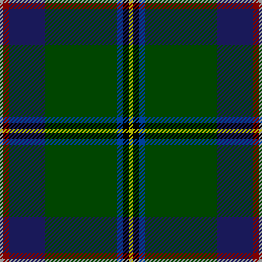
A kilt is a type of knee-length non-bifurcated short dress with pleats at the back, originating in the traditional dress of Gaelic men and boys in the Scottish Highlands. It is first recorded in the 16th century as the great kilt, a full-length garment whose upper half could be worn as a cloak. The small kilt or modern kilt emerged in the 18th century, and is essentially the bottom half of the great kilt. Since the 19th century, it has become associated with the wider culture of Scotland, and more broadly with Gaelic or Celtic heritage. It is most often made of woollen cloth in a tartan pattern.

Tartan is a patterned cloth consisting of criss-crossed, horizontal and vertical bands in multiple colours. Tartans originated in woven wool, but now they are made in many other materials. Tartan is particularly associated with Scotland; Scottish kilts almost always have tartan patterns.

A cockade is a knot of ribbons, or other circular- or oval-shaped symbol of distinctive colours which is usually worn on a hat.

Tartan Day is a North American celebration of Scottish heritage on April 6, the date on which the Declaration of Arbroath was signed in 1320. It originated in Canada in the mid-1980s. It spread to other communities of the Scottish diaspora in the 1990s. In Australia the similar International Tartan Day is held on July 1, the anniversary of the repeal of the 1747 Act of Proscription that banned the wearing of tartan.

Regional tartans of Canada are represented by all Canada's provinces and territories, except for Nunavut, having a regional tartan, as do many other regional divisions in Canada. Tartans were first brought to Canada by Scottish settlers; the first province to adopt one officially was Nova Scotia in 1956, and the most recent province was Ontario, in 2000. Except for the tartan of Quebec, all of the provincial and territorial tartans are officially recognized and registered in the books of the Court of the Lord Lyon, King of Arms of Scotland.
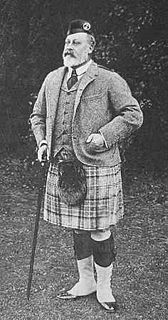
Highland dress is the traditional, regional dress of the Highlands and Isles of Scotland. It is often characterised by tartan. Specific designs of shirt, jacket, bodice and headwear may also be worn along with clan badges and other devices indicating family and heritage.
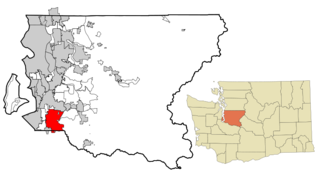
Auburn School District No. 408 is a public school district in King County, Washington, seated in Auburn. The district encompasses a 62 square-mile area bridging King County, Washington and Pierce County, Washington, and serves approximately 75,000 residents in Auburn, Algona, Pacific, and a small portion of Kent, as well as unincorporated census-designated places such as Lake Morton-Berrydale and Lake Holm.

Cornish kilts and tartans are thought to be a modern tradition started in the early to mid 20th century. The first modern kilt was plain black, and other patterns followed. It is documented that a garment known as a bracca was worn by Celtic people who inhabited the British Isles, the term indicating its appearance. The Welsh word brech means "checkered", and the word bracca is derived from the Welsh or Cornish word brythen which in English translates as "striped" or "checkered".

The Scottish Tartans Authority (STA) is a Scotland-based organisation dedicated to preserving and promoting knowledge of Scottish tartans and Highland dress. It was formed in 1996 by former members of the Scottish Tartans Society (STS). The organisation is dedicated to informing and educating the public about tartan, to facilitating research into tartan and Scottish heritage, to representing and supporting the businesses involved in the tartan sector and to maintaining the collection and library of tartan related artefacts, manuscripts and books.

Clan MacEwen or Clan MacEwan is a Highland Scottish clan recorded in the fifteenth century as Clan Ewen of Otter.

Sillitoe tartan is the nickname given to the distinctive black and white chequered pattern correctly known as dicing, which was originally associated with the police in Scotland, but which later spread to widespread use overseas, notably in Australia, New Zealand, the rest of the United Kingdom, and Chicago as well as Pittsburgh in the United States. Elsewhere it is rare, such as in parts of Canada where it is limited to the auxiliary police services.
The uniforms of the United States Army distinguish soldiers from other service members. U.S. Army uniform designs have historically been influenced by British and French military traditions, as well as contemporary U.S. civilian fashion trends. The two primary uniforms of the modern U.S. Army are the Army Combat Uniform, used in operational environments, and the Army Green Service Uniform worn during everyday professional wear and during formal and ceremonial occasions that do not warrant the wear of the more formal blue service uniform.
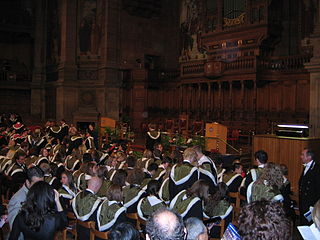
Academic dress at the University of Edinburgh is compulsory at official ceremonial occasions, such as graduation and the installations of Rector and Chancellor, and otherwise optional, usually only worn for events.

USS Washington (SSN-787) is a Virginia-class nuclear powered attack submarine of the United States Navy. The contract to build her was awarded to Huntington Ingalls Industries in partnership with the Electric Boat division of General Dynamics in Newport News, Virginia, on 22 December 2008. This boat is the fourth of the Block III submarines which will feature a revised bow, including some technology from Ohio-class SSGNs. Construction began on 2 September 2011 at Newport News Shipbuilding in Virginia. On 13 April 2012, Secretary of the Navy Ray Mabus, announced SSN-787 would be named after the State of Washington, which was celebrated during a naming ceremony in Seattle on 7 February 2013. The Navy christened Washington on 5 March 2016, during a ceremony at Newport News Shipbuilding in Newport News, Virginia.
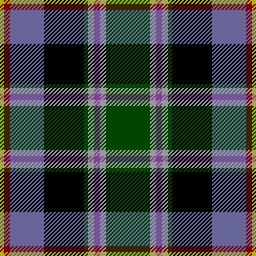
The Colorado state tartan is the Scottish-style tartan pattern officially adopted by the US State of Colorado to represent the state in various functions and occasions.

Meadowbrook High School is a government-aided learning institution located in the suburbs of Kingston, Jamaica. It is co-educational, first-to-sixth form, secondary school located in the community of Meadowbrook in the parish of St. Andrew. It was founded on 13 March 1958 by the United Church in Jamaica and the Cayman Islands.
